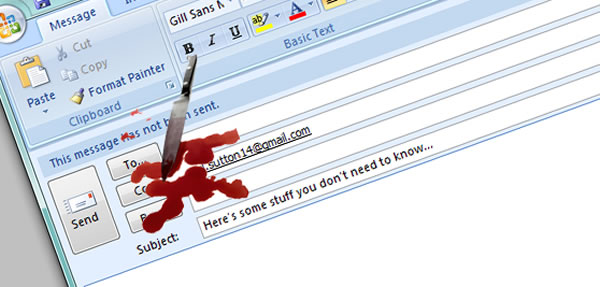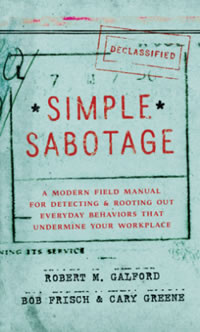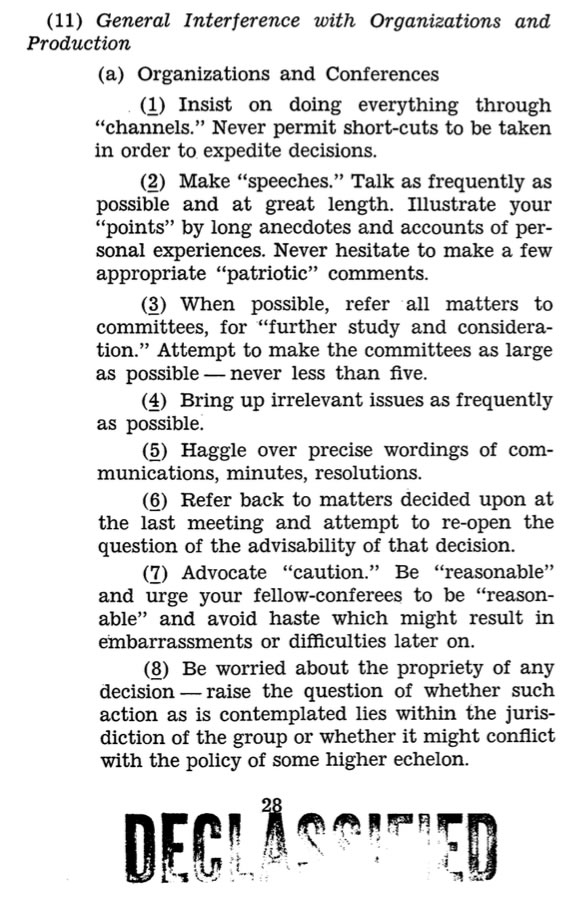
In 1944, back during World War II, the OSS, short for the Office of Strategic Services — the organization that would eventually be replaced by the CIA — published the Simple Sabotage Field Manual, a “Sabotage for Dummies” guide filled with handy tips for resistance members in Europe.
In its 32 pages, it lists a number of acts that could be carried out by ordinary people who want to mess with the Nazis and who aren’t even part of the resistance. The tips listed in the book have the goals of both hindering the Nazis’ ability to wage war and minimizing the risk to the saboteur, who would most likely be a civilian.
You’re not likely to see the acts of physical sabotage listed in this book in your day-to-day life, but you probably see people using the book’s suggestions for organizational sabotage every day at work. What a 1944 book listed as tactics to sabotage an organization are normal behavior for many managers in 2015:
Page 28 of the OSS’ Simple Sabotage Field Manual. Click the image to see it at full size.
Here’s the text from that page:
(1) Insist on doing everything through “channels.” Never permit short-cuts to be taken in order to expedite decisions.
(2) Make “speeches.” Talk as frequently as possible and at great length. Illustrate your “points” by long anecdotes and accounts of per sonal experiences. Never hesitate to make a few appropriate “patriotic” comments.
(3) When possible, refer all matters to committees, for “further study and consideration.” Attempt to make the committees as large as possible — never less than five.
(4) Bring up irrelevant issues as frequently as possible.
(5) Haggle over precise wordings of com munications, minutes, resolutions.
(6) Refer back to matters decided upon at the last meeting and attempt to re-open the question of the advisability of that decision.
(7) Advocate “caution.” Be “reasonable” and urge your fellow-conferees to be “reasonable” and avoid haste which might result in embarrassments or difficulties later on.
(8) Be worried about the propriety of any decision — raise the question of whether such action as is contemplated lies within the jurisdiction of the group or whether it might conflict with the policy of some higher echelon.
The Simple Sabotage Field Manual has more tips for killing productivity, including my “favorite” pro-tip for managers, “Hold conferences when there is more critical work to be done.” If this trick didn’t work, there’d be no market for an entire line of products with the message “I survived another meeting that should have been an email.”

Email didn’t exist in the 1940s, but carbon copy abuse did. One of the tips in the Simple Sabotage Field Manual was:
In making carbon copies, make one too few, so that an extra copying job will have to be done.
For you younger folks, carbon copying was a method of producing multiple copied of a typed letter in the days before photocopiers, never mind computers. This video shows how it was done (as well as why you should be thankful that we don’t live in the dark ages anymore):
Today, carbon copies live have their descendant: the cc: field of emails; “cc” is short for “carbon copy”. And instead of making too few copies, the internet-era version is to send emails that are cc’d to as many people as possible. In its more innocent form, the sender is just trying to be inclusive, but is likely filling other people’s inboxes with messages that don’t necessarily apply to them. In its nastier version, it’s a way to snitch on someone or throw them under the bus by cc:ing their boss and ensuring that “the wrong words go in the right ears”. No matter the intent, the effect is the same: it disrupts work.

 The Simple Sabotage Field Manual was declassified in the 1970s (if you’re really curious, you can download a scan of the book from the CIA; it’s a 2.5 MB PDF file). As a no-longer-secret document, people are free to talk about it, which is what CIA employees Don Burke and Sean Dennehey did in 2008 at the Enterprise 2.0 conference, where the pointed out the strange similarities between 1944 sabotage and 21st-century management.
The Simple Sabotage Field Manual was declassified in the 1970s (if you’re really curious, you can download a scan of the book from the CIA; it’s a 2.5 MB PDF file). As a no-longer-secret document, people are free to talk about it, which is what CIA employees Don Burke and Sean Dennehey did in 2008 at the Enterprise 2.0 conference, where the pointed out the strange similarities between 1944 sabotage and 21st-century management.
The book is referenced again by consultants Robert Galford, Bob Frisch, and Cary Greene in the new book, Simple Sabotage: A Modern Field Manual for Detecting and Rooting Out Everyday Behaviors that Undermine Your Workplace. In their book, they point out that most acts of 1944-style office sabotage are carried out with the best of intentions:
Saboteurs make you think that what they’re talking about is relevant and important when in reality what they’re saying is tangential, unimportant, or even inappropriate. They don’t know they’re doing it, so their earnestness and honesty helps make their case. And the people on the receiving end are instantly, innocently swept off course because they believe what they think they see or hear.
It’s not 1940s occupied Europe, so we can’t simply turn over our work saboteurs to our neighborhood friendly occupying army or take them behind the office and have them quietly shot, as tempting as it may seem (hey, we’re civilized, and we probably report to some of those saboteurs). I’ve got a long flight coming up in a couple of weeks, and since 800-CEO-READ calls Simple Sabotage a “staff pick” and “the perfect airplane read”, I just might order a copy to find out its suggestions for countering office sabotage.


